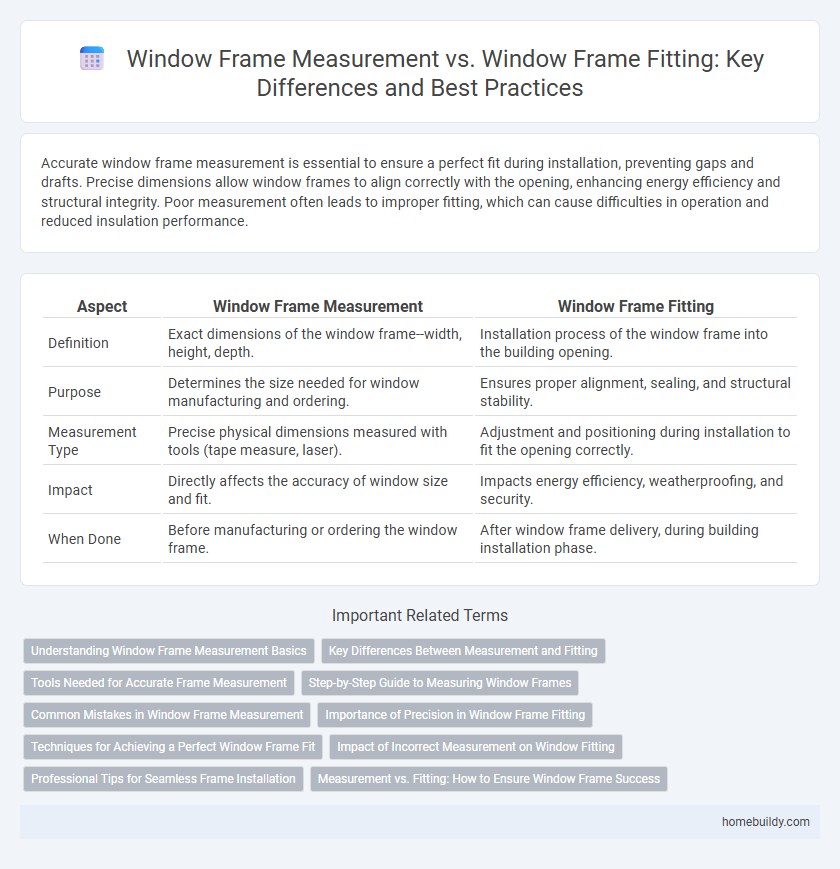Accurate window frame measurement is essential to ensure a perfect fit during installation, preventing gaps and drafts. Precise dimensions allow window frames to align correctly with the opening, enhancing energy efficiency and structural integrity. Poor measurement often leads to improper fitting, which can cause difficulties in operation and reduced insulation performance.
Table of Comparison
| Aspect | Window Frame Measurement | Window Frame Fitting |
|---|---|---|
| Definition | Exact dimensions of the window frame--width, height, depth. | Installation process of the window frame into the building opening. |
| Purpose | Determines the size needed for window manufacturing and ordering. | Ensures proper alignment, sealing, and structural stability. |
| Measurement Type | Precise physical dimensions measured with tools (tape measure, laser). | Adjustment and positioning during installation to fit the opening correctly. |
| Impact | Directly affects the accuracy of window size and fit. | Impacts energy efficiency, weatherproofing, and security. |
| When Done | Before manufacturing or ordering the window frame. | After window frame delivery, during building installation phase. |
Understanding Window Frame Measurement Basics
Accurate window frame measurement is essential to ensure a perfect window frame fitting, preventing air leaks and structural issues. Standard measurement involves capturing the width, height, and depth of the existing frame at multiple points to account for any irregularities. Understanding the difference between rough opening dimensions and actual frame size is crucial for selecting the right window frame that fits securely and enhances energy efficiency.
Key Differences Between Measurement and Fitting
Window frame measurement involves accurately determining the dimensions of the window opening, including height, width, and depth, to ensure precise sizing of the frame components. Window frame fitting refers to the actual installation process, where the measured frame is placed, leveled, and secured within the opening to guarantee proper alignment and structural stability. The key difference lies in measurement being a preparatory step focused on data accuracy, while fitting emphasizes the physical adjustment and fixation of the frame in the designated space.
Tools Needed for Accurate Frame Measurement
Accurate window frame measurement requires precise tools such as a steel measuring tape, a laser distance measurer, and a level to ensure exact dimensions for proper fitting. Digital calipers can enhance precision, especially for depth and thickness measurements, while a carpenter's square helps verify right angles. Using these tools minimizes errors in frame fitting, preventing gaps, misalignment, and ensuring optimal insulation and aesthetic appeal.
Step-by-Step Guide to Measuring Window Frames
Accurate window frame measurement requires precise width and height dimensions taken from multiple points to ensure the frame fits securely and functions properly. Start by measuring the inside width at the top, middle, and bottom of the frame, then record the smallest measurement to prevent fitting issues. Next, measure the inside height on the left, center, and right sides, using the smallest height for an optimal fit, which ensures the window frame accommodates variations in the structure.
Common Mistakes in Window Frame Measurement
Common mistakes in window frame measurement include inaccurate width and height readings due to ignoring the window's depth and uneven surfaces. Failing to measure multiple points and relying on old or damaged frames often results in improper fitting and costly adjustments. Precise measurement must account for allowances like clearance and frame material thickness to ensure seamless window frame fitting.
Importance of Precision in Window Frame Fitting
Accurate window frame measurement directly impacts the quality of window frame fitting, ensuring a secure and weather-tight installation that enhances energy efficiency and prevents drafts. Precision in measuring dimensions such as width, height, and depth allows installers to select or fabricate frames that align perfectly with the structural opening, minimizing gaps and reducing the risk of structural damage. Proper fitting not only extends the lifespan of the window frame but also contributes to improved insulation, noise reduction, and overall aesthetic appeal.
Techniques for Achieving a Perfect Window Frame Fit
Precise window frame measurement requires accurate assessment of width, height, and depth, ensuring allowances for material expansion or contraction. Techniques such as using laser measuring tools or framing squares minimize errors and improve alignment accuracy. Correct fitting involves verifying squareness and levelness before installation to achieve a seamless and durable window frame fit.
Impact of Incorrect Measurement on Window Fitting
Incorrect window frame measurement leads to poor window frame fitting, causing gaps that compromise insulation and security. Misfit frames can result in increased energy loss, water leakage, and difficulty in window operation. Precise measurements ensure a snug fit, maximizing durability and performance of the window installation.
Professional Tips for Seamless Frame Installation
Accurate window frame measurement is crucial for seamless frame installation, ensuring precise dimensions prevent gaps and misalignment. Professionals recommend measuring both width and height in multiple spots, accounting for any irregularities in the rough opening. Proper fitting requires verification of square corners and level surfaces, optimizing insulation and structural integrity for a flawless finish.
Measurement vs. Fitting: How to Ensure Window Frame Success
Accurate window frame measurement is critical to achieving a perfect fit, directly influencing the efficiency and durability of the installation. Precise measurements account for frame depth, width, height, and any structural irregularities to prevent gaps or misalignment during fitting. Proper fitting techniques rely on these measurements to ensure airtight sealing, structural stability, and optimal thermal insulation for long-term window frame success.
window frame measurement vs window frame fitting Infographic

 homebuildy.com
homebuildy.com